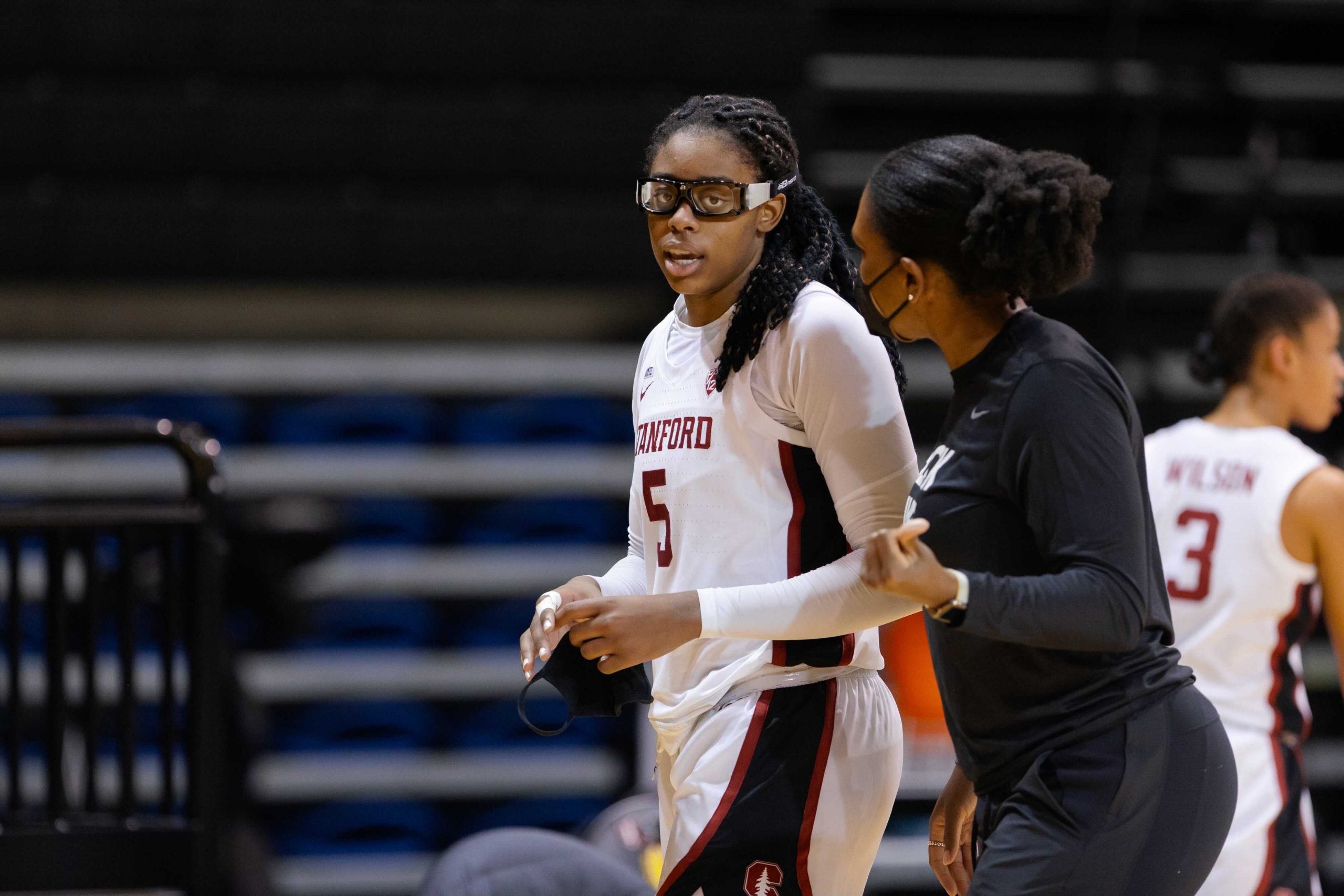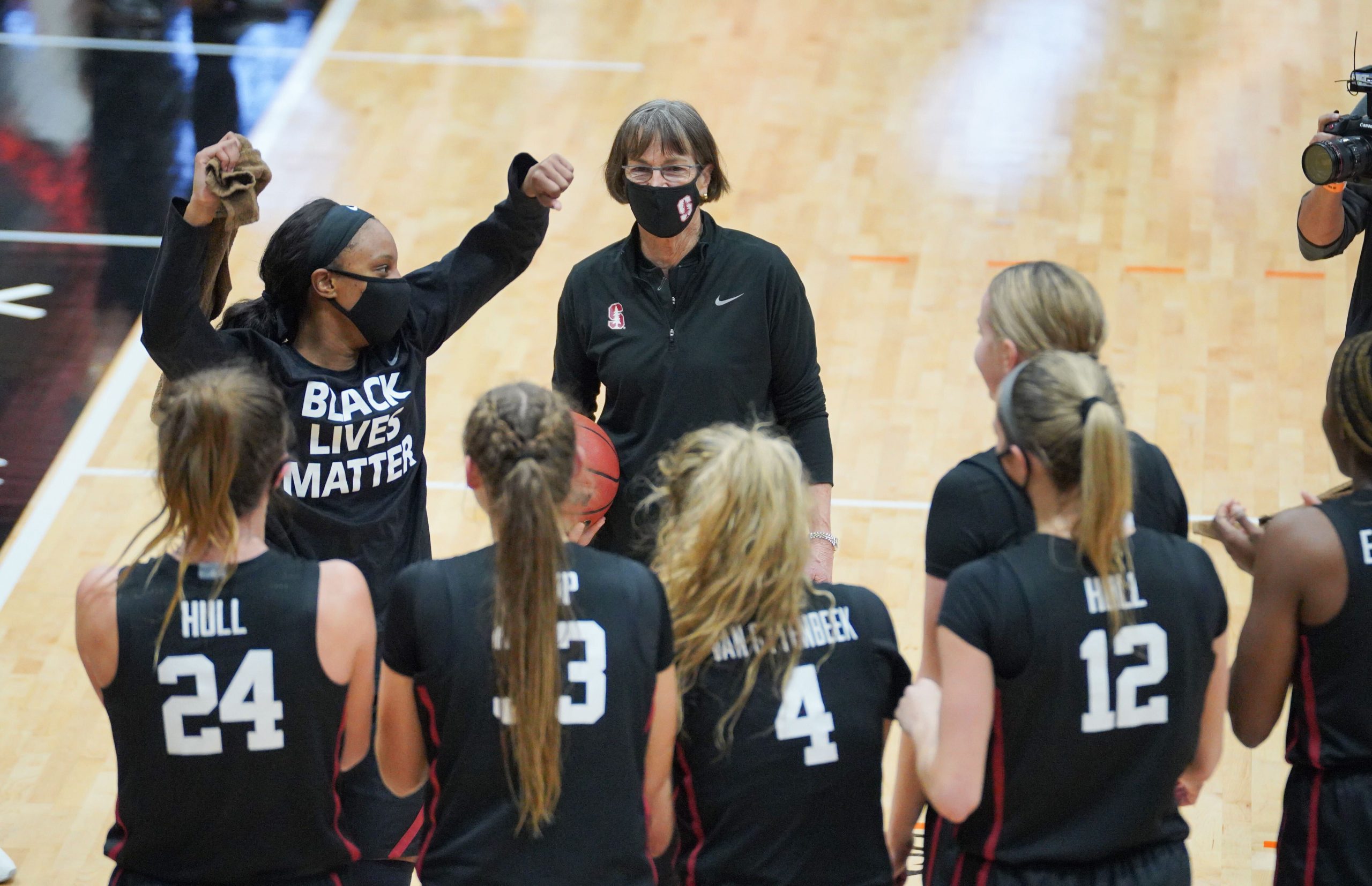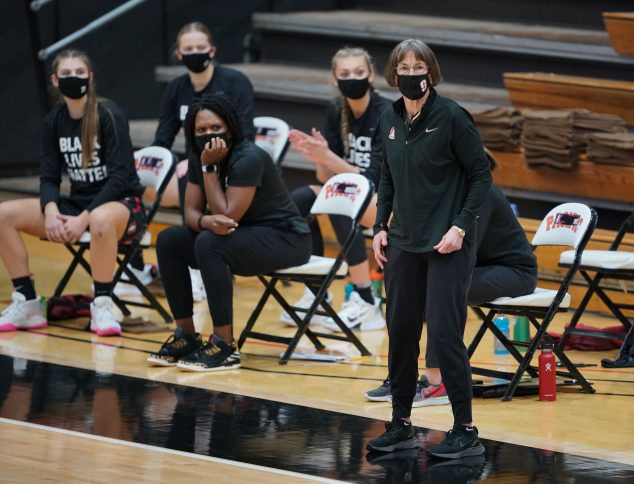Stanford’s Britney Anderson and Baylor’s Alvin Brooks III Highlight the Impact and Lessons Birthed From Their Championship Teams
SLAM has partnered with the Black Coaches Association on a content series that will spotlight Black coaches from every level. Register as a member of the BCA here.
Alvin Brooks III didn’t envision coaching as his future career path. As the son of the legendary Alvin Brooks, who was the first Black head coach in program history at the University of Houston, Brooks grew up knowing just how demanding the job was. While still in high school, he’d often go to games with his father on school nights, staying late in the gym, sometimes until 3 am after a tough loss. Then, they’d still have a 30-45 minute drive back home.
“I’d have school the next day and be like, there’s no way I’m doing this,” Brooks says over ZOOM.
After playing for Midland College, the Houston native transferred to Idaho State, where he graduated with a finance degree, Brooks had initially been more interested in financial advising. Having befriended Rashard Lewis, who was playing on the Seattle Supersonics at the time, Brooks would go to the team practices and quickly became intrigued with how then-head coach Nate McMillian and then-assistant coach Dwyane Casey approached the game. It was then that he thought, perhaps one day, man I could do this.
He initially thought he’d start his career coaching at Texas A&M alongside his father, but Alvin Brooks had other plans.
“He made me start at junior college because he wanted me to be more than a recruiter,” Books recalls. “I was forced to do everything because there were only two assistants.”
Long before he joined Baylor’s staff, Brooks’ first coaching gig was in ‘04 as an assistant at Arkansas-Fort Smith, where he helped lead the Lions to a 2006 NJCAA Division 1 championship. He then returned to Midland and helped his former squad claim another NJCAA title during the 2006-07 season.
Not long afterward, Brooks took his talents to the NCAA-level, where he was an assistant coach and recruiting coordinator at Bradley for three seasons, followed by two seasons as an assistant coach at Sam Houston State from 2010-12. The following season, he joined the coaching staff at Kansas State for four seasons, and then was hired by Baylor prior to the 2016-17 season.
With 17 years of coaching experience under his belt, Brooks has become a key component in Baylor’s championship-winning coaching staff. Before the 2019-20 season was canceled due to COVID-19, the No.1 nationally ranked Bears had embarked on their most successful season in program history, finishing 26-4 with hopes of earning an NCAA tournament No.1 season.
Those ambitions, as we all know, came true this year during a season that, like the previous one, was met with hardship. As the Bears dominated throughout the regular season and finished with an even better record, 28-2, the team also had to navigate the pandemic, and grapple with the reality of the Black lives lost to police brutality. Even with their success, what stood out most to Brooks was how his team built a bond and developed a level of understanding during those times. He learned, especially, how to support his players through it all.
“I think everything helped us become closer as a staff, and helped us grow closer with our student athletes,” he says. “Coach Drew, like he did an unbelievable job of just really showing us how much he cares and he didn’t just talk it. Like he figured out, okay, how can we move steps forward, like he’s a fixer. He had migraines because he was like, how can i fix it? How can I fix it? We’re like, man, there’s really nothing you can fix. Like by yourself, not overnight. So we actually did a lot, we had a lot of team meetings, we had a lot of guys open up and talk about their different backgrounds and got to know one another on a level that we hadn’t before.”
After learning that private prisons look at the literacy rates of third graders and use that to determine the future number of beds in prisons, the Bears decided to volunteer their time reading to and teaching elementary school students over Zoom during the season. As they made their way into the NCAA tournament, guard Jared Butler, a projected NBA lottery pick in this year’s draft, spent his Sundays teaching Sunday school classes to students at Harris Creek Baptist Church in Waco.
“We want to try to make sure that we make a change in our community as far as helping the inner city kids and helping them to where [we’re] not just talking about it but actually doing something,” Brooks says.
Championship teams are built by trust—which is something Stanford assistant coach Britney Anderson has also learned, especially, as her Cardinals also went on a historic-run to claim their first title in 30 years. Like Brooks, she didn’t think coaching was for her, either. And while suiting up for Virginia Tech in college, Anderson flat-out told her own coach that she wasn’t really interested in the profession.
“I felt like they didn’t have a life,” Anderson admits on the same Zoom call. “It wasn’t fun, you’re always stressed out, you’re chasing down kids. I knew how my teammates were so I was like, I just don’t want to do it.”
Still, Anderson ended up giving it a try after graduating from Virginia Tech in ‘07, where she averaged 10.2 points and helped lead her team to three-trips to the NCAA tournament and one to the WNIT, all while earning a degree in apparel design and merchandise management. While working as a corporate recruiter for M.C. Dean in Virginia, she also coached girls’ basketball at Potomac Falls High School in Potomac Falls and AAU in the summer time for six years.
It was then that her former Virginia Tech assistant coach, Bobbie Kelsey, encouraged her to look into coaching at the collegiate level.
“She said to me, hey, you should think about college coaching. She then came back and said it again. And that’s when I kind of was like, well maybe this is my calling, maybe this is my purpose. I honestly had no idea it would get me here.”
While applying for a Department of Basketball Ops position at Radford, Anderson was also told to look into becoming an assistant coach. Yet, she hesitated.
“I’m like, no, I’m just trying this out to see if I like it, and kind of got pushed to being an assistant.”

And yet, she immediately made an impact on the program, assisting with recruiting, scouting, scheduling, and even community service and camp coordination while focusing, specifically, on the wing players. While helping will the program to a redemption season in 2015, where the Raiders led the Big South in three-point shooting, the team made a postseason run in the Women’s National Invitation Tournament. Anderson then returned to her alma-mater, Virginia Tech, in June of that year, leading them to a trip to the WNIT. She joined the Cardinal’s staff last season.
And yet, just as Brooks’ Baylor Bears learned, this season had its challenges for the Cardinals—who played on the road for 10 weeks straight. By the time they made it to the bubble for the NCAA tournament, Anderson was impressed with how her team handled such a long season, which included being away from their families and friends.
“I was proud of our team, it was a long season,” she says. “We were on the road for 10 weeks. I don’t know how we made it. We made it to the end.”

The lessons learned inside the bubble were bigger than basketball. Anderson saw her own players speak up, and speak out against systemic racism and gender-inequality—in reaction to what was going on around the country, and, specifically, after the controversy regarding the NCAA-provided weight rooms sparked. It was during those moments, especially, that she learned how important it was to help her players work through tough moments and use their platforms to create change.
“I was blown away by the whole weight room situation,” she admits. “I was in complete, what is this? I had to go back to my room and collect my thoughts like, okay, what is this? What’s going to come from this? What can we do about this?” Anderson admits. “[Seeing] them use their platform this season was the biggest thing that stuck out. Yes, we won a national championship, yes it was a marathon and all that. But I learned a lot this season about this next generation [and] how when athletes speak up, things change, things can happen. I think that was the biggest that I got out of the season—that we just need to continue to speak up, and when these athletes want to speak up or feel the need to speak up, help them use their voice because they’re not always sure how to go about something and they want to come across to where people will listen to them.”
As the Cardinals prepared for the second round of the NCAA tournament, Anderson made the decision to wear her team-issued Black Lives Matter shirt to every game throughout the postseason, despite backlash.
“To be honest with you, I got a lot of people who were like, well you don’t match everybody else. And for me it was bigger than the game, we’re here, we’re playing. Me wearing this t-shirt doesn’t affect how our team plays. But I just made a decision to continue to wear it. If people had issues with it, people sent me messages, but I said, you know imma just wear this shirt. It’s one of those things where you go through the tournament, you’re dealing with everything we’re dealing with and you realize basketball is just a piece of everything that’s going on around us.”

Brooks admits that he’s also had moments during his own career where he feels like it was important to speak up against racial tension. While suiting for Idaho State, he saw a clear-divide between teammates of different races and backgrounds, specifically when traveling to games on the team vans. There, Brooks says six Black players would sit in one car, while six white players would be in another. When the team would go out to eat all the Black players would sit at one table together, while the white players would sit separately.
“Me, being the team captain, I probably could’ve fixed that but you know I was kind of selfish because K wasn’t playing as much as I thought I should,” he admits. “I see those things now and I’m able to say no no no no that’s not what we doing.”
Now, Brooks says he’s learned just how important it is to coach based on the needs of his players, and to support them outside of the game, especially when it comes to societal issues and things they may be dealing with, or exposed to on their social media feeds.
“These kids are exposed to a lot more, they see a lot more,” Brooks adds. “Life comes at them faster, especially with social media, [and I’m] helping them get through that. These kids want to know you care about them outside of basketball first before they’re going to trust you on the court.”
Having both learned how important it is to use their platforms, and to encourage their players to do the same, both Brooks and Anderson also believe that it’s important to support other Black coaches around the game, too. Given the limited opportunities for Black coaches, there’s often a sentiment of competitiveness between each other:
“I feel as Black coaches we feel like there can only be one on a staff,” Anderson says. “And we don’t want to share too much of what we have learned in situations or even to help somebody get through something. I came from Virginia Tech where the head coach is a Black male, and it was myself and another black female as an assistant. I think that can be the norm, but I think it’s not something that we see on a daily basis so it’s something we don’t think about. I think we’re seeing it more.”

When she got a DM from BCA co-founder Pooh Jeter asking her to join the BCA’s ZOOM meetings, Anderson admits she was intimidated at first, having just moved to the west coast and not knowing too many other coaches.
“It opened my eyes to more as far as there’s other coaches that are out here that I can reach out to that have more to share but sometimes we don’t reach out to each other because it’s like they’re not going to respond. And I had made it a point even when I got into this business that anybody reached out to me. If I can help you, I’ll help you. If it’s a player that I know you’re interested in and I can’t get them, and you can get them, I’ll help you. But I think with that organization it’s becoming more of how we can help each other. I went from sitting on the first call like, I don’t know, like, I’m here to be able to see that this is something that can grow and this is something that is very unique in that this is the first time I’ve been on that call and I’m pretty sure I’m not the first person that’s been a part of something like that.”
For Brooks, whose father was a part of the original BCA that formed in the ‘80s and ‘90s, he grew up hearing stories about John Thompson, John Chaney and the meetings they led.
“I thought that generation did an unbelievable job of helping one another, I mean they would go on recruiting trips with each other and recruit the same kid and be in the same car at different schools and wait for one another. Well now, my generation, we won’t even tell you where we’re going to recruit because we see it as competition and I think the BCA can bridge that gap. As far as getting all of us to see that we’re not enemies, it’s just competition and I think they understood back in the day that it’s just competition but we still got to help one another where I think some of us look at each other as enemies. And it’s like, bro we’re not enemies, we all can succeed in this business. But we definitely can’t do it alone.”
He adds: “The only way we can do it is if we do it together. And so I think the BCA calls are great because I get on and I take notes, I learn from everybody. I’ll take notes and try to figure out what it is that I can learn from this person? And so if they’re willing to share knowledge then it’s up to me to take it and apply it.”
—
Photos via Getty Images and Stanford Athletics (via Britney Anderson).